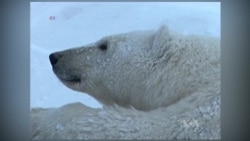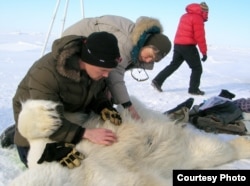Sea ice in the Arctic is melting faster than predicted, which is bad news for polar bears that hunt, mate and raise their young on the ice.
A new study looks at the impact of ice loss on their health. Co-author Merav Ben David, who was among a team of University of Wyoming researchers whose field work in the Arctic is the basis for the new study, said that "many colleagues, even some on our own research team, doubted whether the study was possible, until we actually did it."
Starving on Melting Ice
“With shortening of spring hunting season, lengthening of summer season when they are food-deprived and still experiencing difficulties in gathering food in the winter, polar bears are stressed physiologically," Ben David said. "They have to rely on stored energy gained in spring to survive most of the year. If they don’t get enough food in the spring, the bears begin winter in poorer shape."
Traveling by helicopters and icebreakers to remote Arctic regions, the team captured more than two dozen bears, taking blood samples and implanting sensors to track temperature. Between 2008 and 2010, the team monitored the bears’ movement on ice and on shore.
“This project was logistically so intense that it may never be replicated," said co-author Hank Harlow, an eco-physiologist and colleague of Ben David’s in the University of Wyoming Department of Zoology and Physiology.
Walking Hibernation
Earlier work suggested that the bears could somewhat compensate for lack of food in the summer by going into a walking hibernation, slowing their activity and metabolic rate to be similar to what happens to bears in the winter. Ben David said this study proved otherwise.
“We found that polar bears, like their nearest relatives, the brown bears, are incapable of reducing their metabolic rate to the level that we see during winter hibernation," she said. "We saw a gradual decline, but nothing even close to what bears do in regular hibernation, which means that they cannot conserve as much energy as we thought .There are limits on how long the bears can go without feeding in the summer."
The summer activity and body temperature of bears on shore and on ice were typical of fasting, nonhibernating mammals, with little indication of walking hibernation.
Because of the ice melt, bears are forced to swim longer distances for their meals. The study found they can withstand the frozen water by temporarily cooling the outermost tissue of their body core to form an insulating shell.
The authors are not sure how long they can swim and still survive. In an earlier publication, the authors found that in a nine-day, 643-kilometer swim, a pregnant bear lost 22 percent of her body mass, as well as her cub.
Climate Change
Between 20,000 and 25,000 polar bears live in the Arctic. Ben David said the study adds to the urgent call to protect them. “If we want to be responsible citizens of this planet, we have to do everything in our power to stop, reverse the trend of sea ice loss,” she said.
She said nations of the world must rein in the greenhouse gases that are warming the planet, pushing the polar bear to extinction.











